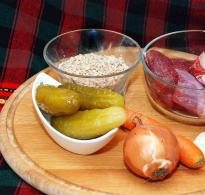Do I need to gut the flounder. How to clean flounder - the sequence and stages of cutting
For tender meat and high nutritional value, flounder is often called "sea chicken". But only if you know how to clean flounder, you can count on getting gastronomic pleasure from eating fish. To learn how to properly prepare a product for heat treatment, you will have to familiarize yourself with the features of its defrosting, soaking, cutting and cleaning. These manipulations are mandatory before frying, boiling and stewing fish. You should not count on the fact that the skin and fins can be carefully removed from the finished product. Such an approach will only spoil the initially high-quality and useful product.
Features of defrosting sea fish
Many housewives make mistakes already at the stage of defrosting the product. Depending on whether the whole carcass is used or only its fillet, you need to proceed as follows:
- Whole flounder. In cold water, dilute a little salt (about a teaspoon per liter of liquid), dip the fish into it. We are waiting for the complete defrosting of the product, this can take from 1.5 to 3 hours. During this time, you can change the water several times to fresh, not forgetting to add salt. Some housewives use warm water to defrost and clean the product faster. This should not be done, because even a slightly warm liquid can adversely affect the structure of the protein.

Tip: Before you start cleaning a chilled product, you should soak it in milk for literally a quarter of an hour. This will get rid of the specific smell of algae, which often comes from marine fish.
- A piece of fillet. First, grease the product with fine salt, then wrap it with cling film and lower it into a container with cold water. Keep as long as necessary, changing the water if necessary. Re-sprinkle the component with salt and wrap it again with a film is not necessary.

Only by adhering to the above rules will it be possible to preserve the main amount of minerals and other chemical elements for which this sea fish is so famous. If you resort to traditional methods of processing the workpiece, it can become almost useless and tasteless.
Procedure for cleaning the product
You will not have to spend a lot of time and effort on the cleaning process of the component, if everything is done correctly, taking into account the sequence of manipulations.
- Thoroughly rinse the defrosted or chilled product under cool running water, getting rid of dirt, sand, traces of algae.
- Some types of flounder have dense scales on the surface of their skin, which must be removed in the traditional way, using a suitable knife or special tool. Such varieties of fish have a very delicate skin, which becomes edible and very tasty after heat treatment.
- With flounder without scales, the skin should be removed, because. after frying or boiling it becomes very hard. It is not necessary to clean a very small flounder, its skin is usually chewed without problems.
- To remove the skin, do the following. We remove the tail and fins from the carcass, they will interfere. Next, we make a longitudinal incision on the back of the fish on one side, we cling to the edges of the skin and in one motion remove it like a stocking.
- Lastly, we proceed to remove the head of the fish. This sequence of actions will prevent damage to the product and facilitate the process. This is due to the fact that the digestive organs of this animal are not located on the belly, but directly under the gills. If, during the manipulation, the contents of this bladder are damaged, it is unlikely that it will be possible to wash off the bitter taste of bile from the meat. For high-quality and quick removal of all unnecessary, you should make an angled cutout in the shape of the letter V right under your head. Do not spare the fillet, it is better to grab a little more product than necessary.

Now we need to complete the procedure correctly. We wash the carcass of the flounder again under running water, add it and put it in the refrigerator for 20-30 minutes. Ideally, it is recommended that the component be not just salted, but marinated before heat treatment. This will completely get rid of unnecessary odors and tastes. Now it remains to rinse the blanks again and you can use them for their intended purpose.
How to clean a flounder to get its fillet?
In many recipes, it is required not only to clean the fish, but to remove the fillet from it. It is very easy to do this. It all starts with the removal of fins, tail and skin (if necessary). Next, we make a V-shaped incision in the head area, from which we make a vertical incision along the entire length of the back of the carcass.

In the head part of the fillet we hook it with a knife and begin to move down, separating the product from the base. The second half of the product is processed in the same way. At the end, the head is cut out, the spinal bone is removed, the remains of the component are cut off.
It is even easier to get fillets from small flounder carcasses, which also need to be cleaned before being fried whole. Here, first of all, we cut off the head, after which we cut the element along the ridge line into two parts. From the resulting halves, we extract the bones, cut off the fins and parts of the tail. Thoroughly wash the resulting fillet in a thin skin, add salt, marinate if desired and cook according to the recipe.

If during the processing of the product its insides were damaged, the blanks should be soaked, marinated, and various aromatic herbs and spices should be used during processing. But even this does not guarantee complete elimination of the specific aroma and bitter taste.
Flounder is sometimes called "sea chicken" because of its dietary meat, which contains a large amount of nutrients and has a delicate texture and pleasant taste. This product has practically no contraindications, saturates the body with omega-3 fatty acids, strengthens blood vessels, removes free radicals from the body, lowers cholesterol and is an aphrodisiac. With all its merits, this fish is rarely seen on the tables due to the fact that many housewives do not know how to clean the flounder correctly.
Preparation and storage of fish
Of course, it is best to cook flounder immediately after being caught. But in our reality, this fish reaches the consumer in a frozen form, so you need to know how to prepare it for frying.
Before cleaning the flounder before frying, it must be thawed according to all the rules at home. This will preserve the maximum amount of vitamins and minerals necessary for health in the fish. Fish can be thawed in two ways:
- in a refrigerator;
- in salt water.
 The most natural way is to defrost the carcass in the refrigerator. This method is suitable for housewives who are not in a hurry. Flounder in a plastic bag is placed on the bottom shelf of the refrigerator and wait until it completely thaws. The process may take 10-12 hours.
The most natural way is to defrost the carcass in the refrigerator. This method is suitable for housewives who are not in a hurry. Flounder in a plastic bag is placed on the bottom shelf of the refrigerator and wait until it completely thaws. The process may take 10-12 hours.
If the dish needs to be prepared as soon as possible, then there is another way. The frozen fish carcass is placed in a large bowl, cold water is poured and salt is added in the proportion of 1 teaspoon per kilogram of fish weight. Hot water should not be used in this case, as it will make the fish meat flabby and tasteless.
After thawing, the fish is washed in running water, removing salt residues and dirt.
Cleaning flounder from scales
Answering the question whether it is necessary to clean the flounder before frying, it is worth saying that this process is necessary. Different types of fish can be both with scales and without it. In the first case, you need to get rid of scales. To do this, you need to follow a certain technology:

If the scales have dried up and cannot be processed, the fish should be left for some time in cold water. After that, cleaning will be much faster.
On the Internet you can find many detailed videos on how to clean flounder from scales.
How to properly cleanse your skin
It is necessary to remove the skin from a fish without scales, as it is too elastic, thick and after cooking it gives the dishes a nasty aftertaste.
Skin removal process:

Butchering and gutting
 The head of the flounder is removed last, since the organs of this fish are not located in the lower part of the body, but immediately under the gills. If you cut the product inaccurately, you can damage the gallbladder, which will negatively affect the taste of the future dish.
The head of the flounder is removed last, since the organs of this fish are not located in the lower part of the body, but immediately under the gills. If you cut the product inaccurately, you can damage the gallbladder, which will negatively affect the taste of the future dish.
In order to separate the head, a V-shaped incision is made on both sides of the fish, after which the head is carefully removed along with the insides. You need to do this in one quick movement.
Cutting flounder for frying is completed by thoroughly washing the carcass under running water. Then the fish should be sprinkled with fine salt and put in the refrigerator for half an hour.
To get rid of the sharp fishy smell, there is another proven method. Cut flounder can be soaked in milk for 25 minutes. After that, the unpleasant odor will disappear, and the meat will become much more tender.
Fillet cutting
If the hostess decided to fry the flounder fillet, you must first prepare the fish. To understand how to gut a flounder on a fillet, you need to study the whole process:

Butchering flounder







True gourmets have great respect for flounder, which is not in vain called sea chicken. This fish has very tender and juicy meat, rich in iodine and all kinds of vitamins. Therefore, flounder can rightly be classified as a dietary product. True, experts say that if a fish is not cooked a few hours after the fish is caught from the sea, you can forget about its excellent taste. It is for this reason that it is best to buy flounder not frozen, but fresh. True, in this case, you will have to cut it yourself, which requires certain skills and dexterity.
We clean the flounder
First, the flounder must be washed under running cold water, removing the remains of sand and algae from the surface of the body. Depending on the variety, the flounder can be with or without scales. In the first case, with the help of a sharp knife, it must be carefully removed, while not removing the skin from the fish, which is quite soft and quite edible. In those species of flounder that do not have scales, the skin is usually quite tough and not suitable for food. It must be carefully removed before cooking the fish. The exception is small flounder, with a soft skin that can be fried without additional cleaning.
For, to carefully and correctly remove the skin without damaging the meat, you should make a small cut along the back of the fish on one side, then pick up the edges of the skin and remove them like a stocking. In this case, the tail and fins are best removed in advance so that they do not interfere with cleaning.
The head is separated from the body at the flounder last. Moreover, for this, a V-shaped incision should be made on both sides, after which the head should be carefully removed along with the gills and entrails. The thing is that the digestive organs of the flounder are not in the lower part of the body, but in the upper, immediately behind the gills. This, on the one hand, makes it easier to clean the fish, since there is no need to open its belly, and on the other hand, it creates additional problems. The thing is that the insides of the flounder must be carefully removed, otherwise there is a very high probability that, due to bile, the taste of the finished people will be very specific. With a touch of bitterness and seaweed. To avoid this, the intestines must be removed entirely, in one go. If you immediately cut off the head, then it is unlikely that it will be possible to clean the flounder after that.
After the skin is removed from the fish, and the insides and fins are removed, the carcass must be thoroughly washed again under cold running water, then salted and left in the refrigerator for 20-30 minutes. Then the fish is rinsed again and only after that it is subjected to heat treatment. Pre-salting of flounder is needed in order to minimize unpleasant odor and taste., which is typical for some varieties of marine fish. After such treatment, it will almost completely disappear.
Small flounder carcasses are not skinned and are usually fried whole. However, they are divided in a different way. In this case, the head is immediately completely separated from the body, and then the carcass is cut in half along the ridge with a sharp knife. After this procedure, the entrails and bones are carefully removed, and the resulting sirloins are thoroughly washed with running water, salted, then washed again and fried or baked in the oven. True, it should be borne in mind that in this case the flounder needs to be salted a little longer, about an hour. You can also remove the unpleasant smell and taste, which will certainly be present due to bile, with the help of warm milk, in which the flounder fillet should be kept for 15-20 minutes.
Question: " How to properly clean a flounder?” - more than one person asked himself. And all due to the fact that the body structure of this fish is slightly different from the structure of its relatives. The flounder is a special type of sea fish that is unmistakably recognizable due to the fact that its eyes are located on only one side of the body. Properly cleaning such fish is not an easy task. In our article we will tell you how to clean it.
Flounder not subject to long-term storage, it is desirable to eat immediately after purchase. But if you still want to keep the fish longer, then this can be done with the help of a freezer: the flounder can be stored in it for no more than 4 months.
Flounder is one of those types of fish that contain a fairly small amount of calories: only 83 calories per 100 grams of the product. Dishes from such a fish are perfect for diet food, and all fats are very easily absorbed by the body.
This fish can cause harm only if a person is allergic to fish. In addition, you need to be careful with the use of this product for those who are prone to diseases of the kidneys, liver, and also suffer from stomach ulcers.
How to properly clean fish?
Before cleaning the flounder, it must be properly thawed if it has been frozen. Many neglect this advice, and subsequently the taste of the finished fish leaves much to be desired. To prevent this from happening, it is necessary to fill the frozen fish with cold water with the addition of salt and let it brew for several hours. During this time, the flounder will successfully thaw and will not lose its taste at all, and it will also be easier to clean.
Now let's move on to cleaning. To get rid of the insides, you need to put the fish with dark scales up, carefully cut off the head, and then make an incision on the belly along the entire body of the flounder. Using a knife, get rid of the insides, paying special attention to the black film, if any. Then pick up the skin with your fingers and slowly remove it, being careful not to damage the meat. After that, you should thoroughly rinse the flounder, and then clean it of bones, if necessary.
Also don't forget to get rid of the fins flounder. This must also be done carefully and slowly, so as not to accidentally damage the meat. Be careful, the fins can be difficult to remove. You can cut them with a knife if you are afraid to spoil the carcass.
After all this, your fish will be prepared for further manipulations. In this way it is very good to clean the flounder for frying, only in this case it is not necessary to pull out the bones. If you want to get a flounder fillet, then you will have to work hard to get rid of all the bones that are in the fish. In fact, cleaning flounder is not at all difficult, the main thing is to know the sequence of actions.

Everyone has heard about the benefits of flounder, but few people like to cook it. And this is due to the fact that the preparatory stage of processing seems terrible, because this flat fish needs to be cleaned and then cut. Let's deal with all the intricacies of handling this marine fish.
Product value
The flounder is a fish with a flattened body, eyes on one side, a brighter upper part of the body, turned upwards. She has the ability to mimic, has earned the recognition of gourmets, affectionately calling her "sea chicken". Even those who have tried flounder only once note the unique and delicate taste of white meat. The flounder fillet contains about 20% of the daily requirement of proteins necessary for a person. Moreover, the amino acids in this fish are balanced so that they are easily digestible, that is, they are even suitable for a diet menu.
Flounder meat contains only 3% fat, is low-calorie (about 83 kcal), rich in vitamins A, E and B.
Eating flounder, we get not only vitamins, but also trace elements:
- phosphorus (strengthens teeth, skeleton, hair and nails);
- iodine (normalizes metabolism);
- fatty acids (cancer prevention).
How to defrost fish
You will not need any special tools for cleaning flounder - except perhaps a sharp knife, an iron sponge for washing dishes (the latter is for cleaning small fish). But there are some nuances to consider. It is better to cook fresh fish, as over time it loses its beneficial properties. But if going fishing for fresh flounder is not your case, then you can get by with a freshly frozen carcass. And in this case, it is important to defrost the fish, since it is impossible to clean and gut frozen fish.
If an already cut and cleaned carcass has been frozen, then it must be thawed at room temperature.
There are 2 options to bring the sea chicken "on alert":
- natural way - suitable if you do not need to rush anywhere: put the fish in a bag and put it on the bottom shelf in the refrigerator until completely defrosted;
- accelerated method: place the carcass of the fish in a bowl of salted water (1 tsp of table salt per 1 kg of flounder weight).
Do not try to speed up the defrosting process with hot water: it destroys the protein and other nutrients in the fish.
The thawed carcass should be washed with cold water, remove sand and salt crystals, mucus, algae residues.
When do you need to clean the flounder and how can you do it?
Usually, the fish is cleaned of scales in an industrial way, immediately after the catch. However, there are exceptions (especially if this is your catch). In this case, the scales can be removed with a knife or a washcloth scraper, but most often they simply remove the skin from the flounder. This is the fastest way to clean fish.
Depending on the species (star-shaped, royal, tiger and others), flounder can be with or without scales. In the first case, she has rather soft skin. The second is hard, and it contains more iodine, which can give the finished dish an unpleasant aftertaste. Therefore, for cooking, it is better to remove the skin.
How to properly remove the skin along with the scales and remove the fins
- To remove the head, we make 2 incisions from the side of the ridge and cut off the head along with the insides. This can not be done separately, as the gallbladder can be damaged. The released bile will give the meat an unpleasant bitterness.
- We put the fish so that the light skin is on the bottom.
- Cut off the fins and tail with scissors.
- We cut the skin along the perimeter of the carcass (along the line of the fins and at the tail).
After removing the fins around the perimeter of the carcass, shallow incisions are made to remove the skin
- We pry off the skin cut at the tail with a knife and carefully separate it, then we put our fingers under the skin and slowly tear it off the meat, as if we were removing a stocking.
The skin from the flounder, when properly cut, is removed easily, like a stocking
- We also remove the skin on the other side.
- We scrape the blood from the ridge.
How to clean a flounder with skinning - video
How to clean small fish, what to do with spikes: useful tips
- It is not necessary to remove the skin from small species of flounder, it is enough to cut it into two parts along the ridge line to remove the bones.
- To clean small fish, you can use a hard brush, such as a metal sponge for washing dishes.
- If your catch has spikes on the top, then they can be left and removed, like bones, during the meal.
The usual way to remove scales - video
How to gut and butcher a fish
If you need meat on the skin to cook a dish, then the flounder needs to be gutted. Getting rid of the insides of labor will not be.
- Cut off the tail and fins (you can use culinary scissors).
- From the head on both sides we make an incision in the shape of the letter V.
- We separate the offal from the body and remove it along with the head.
Due to the unusual shape of the body, the insides of the flounder are not located like other fish, but are located immediately under the gills.
How to fillet large fish
Only large fish are suitable for separating the loin, for example, royal or striped. During the filleting process, the skin can be cut in two ways:
- from chopped pieces (after removing the fillet from the bones);
- from the whole carcass (before removing the fillet from the bones).
How to fillet a large fish with skin removed from pieces
For the first option, you do not need to first remove the skin from the fish, just peel off the scales and gut.
- We remove the head and the insides of the flounder.
- We put the carcass on the bright side.
- We make a cut along the ridge.
- Cut off the tail.
- With a knife, carefully remove the half of the meat with the skin, cutting it off the bones.
- Cut the fillet from the second part.
- We turn the fish over and remove the fillet from the abdomen in the same way.
- We put a piece on the skin, with a knife we cut off the part that is adjacent to the fins - fat.
- Repeat with each piece.
- From the tail section we make a notch with a knife, separating the meat from the skin.
- Remove the skin from the meat in one motion.
- We process the rest of the pieces in the same way.
Filleting of fish with skinning from a whole carcass
Before filleting, remove the head along with the insides and remove the skin with a stocking.
- We put the flounder with the dark side up.
- We make a neat incision from head to tail along the line of the ridge.
- We put the tip of the knife into the resulting incision, remove the fillet along the bones, lifting the flesh.
- Turn the carcass over to the other side and repeat all the manipulations.






